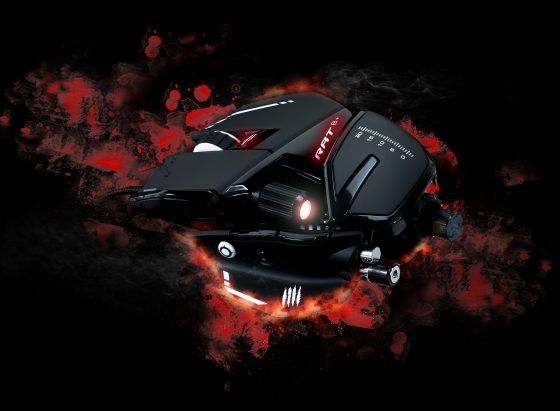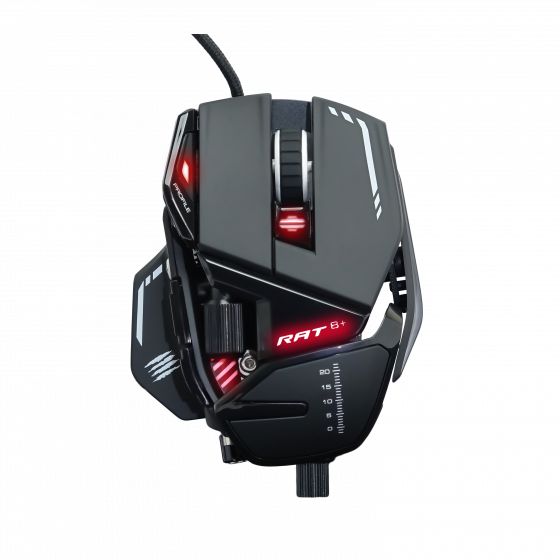Disclaimer: Reviewer was provided with a free sample to review and keep.
To say that MAD CATZ has a stilted legacy is a mild understatement to veteran gamers. Growing up with the first generations of 3D consoles, MAD CATZ peripherals were everywhere in the gaming market, especially with the dawn of the Nintendo Gamecube and Playstation 2. These were certainly not the paragons of quality gamers came to expect from first-party peripherals, but that would quickly change with the diversifying market of PC Gaming. MAD CATZ has always been known for mastering one thing: mice.
The R.A.T. line of mice has extended back to before the company’s bankruptcy and subsequent buyout in 2017, with quality always at the forefront alongside its undeniably futuristic design aspirations. One of the most celebrated of the line, the original R.A.T. 5, is still to this day touted as a paragon of the series. With the relaunching of the MAD CATZ brand, the company has done the same with its line of mice, updating them with newer features for newer hardware. Alongside the R.A.T. 4+, 6+ and Pro S3, today we’ll be reviewing the R.A.T. 8+, touted as being, ‘designed for the professional gamer.’
A Return To Shifting Excellence
Like the mice that came before it, the R.A.T. 8+ is gritty, futuristic, and utterly customizable. Being one of the best-known features of the line, the 8+ is just as adjustable as its brethren, from the chassis to the grips and beyond. The actual width of the mouse as it comes in the packaging is rather standard, matching the original R.A.T 8 at just over two inches. The 8+ also comes with tools on-board to assist with adjusting its shape to meet your exact specifications and needs.

Featuring adjustable thumb wings and palm rest, the 8+ allows gamers of all ages and sizes to maximize their comfort around its central frame and modify the grip as needed. Even with both rests fully extended, the 8+ is still just as sturdy as when it is closed, owing to its solid-chassis construction. Contained additionally in its packaging are a host of grip-pads, allowing users to switch their rests to a more textured face, or wing both their thumb and pinkie rests for palm-gripped players.
Aside from being a sturdy piece of hardware, the R.A.T. 8+ also comes with the same modifiable weight as its predecessor. Hosting three 18 gram weights, the mouse even without them is incredibly heavy owed to its metal-body, weighing in at 145 grams. While it gives the 8+ a sturdy, almost powerful feel players who rely on swift and sudden reactions may find the weight jarring as they adapt to it in their work and gameplay.
However, despite this customization, I found my somewhat larger-sized hands consistently struggling to find a comfortable rest on the mouse. Being a palm-grip player, I enjoy larger mice such as the Razer Naga or Corsair M65, which allow me to make as much contact as possible. Using the R.A.T. 8+, even with every aspect of it fully extended, I continued to feel as if my hand was draped over the edges, instead of hugging it as necessary. This, on more than one occasion, caused strain after several hours, with most of my weight falling onto the palm rest directly behind the first knuckles of my fingers.
Quick To The Click
Boasting a PIXART PMW 3389 Optical Sensor, the 8+ certainly isn’t lacking in robust movement, able to accelerate up to 50G’s in a near instant. Tracking is wonderfully optimized, with no detectable drifting in any movement on standard speeds. The preset DPI’s, while extremely fluid, are perhaps a touch odd. Unlike other currently available gaming mice, each DPI setting that comes out of the package is either just a touch too fast, or a miter too slow, making original adjustments to the feel of the mouse awful and clunky.
The overall build quality of the 8+ is unquestionable in its design, featuring eleven programmable buttons and a thumb-based macro button for quick reactions, all built as sturdily as the chassis. The wheel itself is mechanical in nature, giving wonderful feedback without the droning clicking that cheaper mice like to whine. The main mice buttons are built on Omron switches, guaranteed for 50 Million clicks over the mouse’s lifetime, though their latency is comparable to that of the Logitech G Pro. While I haven’t nearly reached that number, I certainly prefer the continued theming of longevity over speed.

Frankly, the 8+ just feels good to use in all manner of games and programs. It is just as quick on the uptake in games like Overwatch as it is in graphical design programs like GIMP 2. There’s never any issue in the accuracy using the R.A.T.; I never feel like I’m moving too quickly and losing control of my cursor. From fine movements in video editors and the hectic actions in the battlefields of World of Warcraft, the 8+ holds its own.
Customization? Can’tomization.
This is where the R.A.T. falls apart at the seams. Despite having a readily accessible button to switch user profiles, up to 4 for different presets, the touted Flux Interface for the 8+ and the rest of its lineup is dreadfully absent at the time of review. Similar to Razer’s Synapse or the Corsair Utility Engine, the Flux Interface is supposedly designed to offer the ultimate level of customization to every button and digital setting of the R.A.T. lineup. The program does not automatically install, as it does with the Razer series of mice, nor is it available on the MAD CATZ website. This means that every digital feature, including the touted Chameleon RBG Lighting, is as stock as it comes.
Overall 7/10
The R.A.T. 8+ shows an incredible amount of promise in its form and figure, but has a number of setbacks that stop it from really meeting the baseline needs of the ‘professional gamer,’ it’s looking to sell to. While it features an incredible depth and breadth in customization, and its core is sturdy enough to stand the test of time, its versatility causes problems for players who fall along the outliers. A distinct lack of digital interface means that personalization for the 8+ truly only goes skin deep, meaning that its true potential simply cannot be unlocked.
Pros:
+ Incredibly customizable exterior for a wide range of users
+ Sturdy form and electronics built for longevity
+ Accurate even at higher DPI speeds
Cons:
– No Flux Interface means buttons, colors and digital customization cannot be altered
– Weighty, even with extra weight removed
– Uncomfortable for those with larger hands
Related: 8+
Comments
Post a Comment